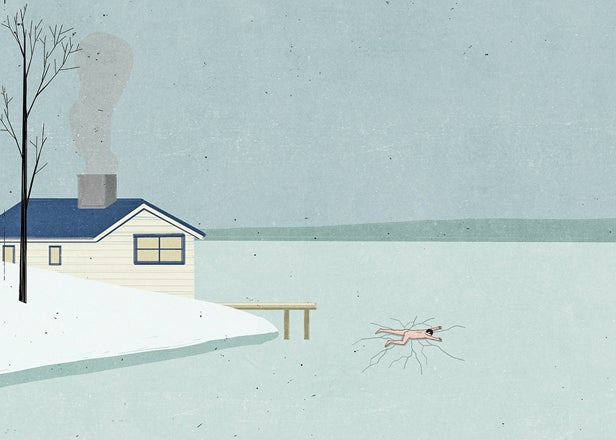Q. Do cold plunges really offer health benefits?
A. Records describing health-related cold plunges date back to the fifth century b.c., when ancient Egyptians, Romans, and Greeks purified themselves in chilled baths to promote general well-being. Scandinavians have taken post-sauna dips in icy water for more than 1,000 years.
Modern experts are split on whether the old-timers were on to something. Cold plunges, now used by everyone from football players to Olympic athletes, are certainly rejuvenating, since they stimulate the release of norepinephrine (a stress hormone and neurotransmitter) and epinephrine (a.k.a. adrenaline), both of which feel invigorating when they course through the body. According to Anne Bramham, who founded the American Spa Therapy Education and Certification Council, going from hot to cold is a great cardiac workout that elevates the pulse rate and increases circulation. “It’s an excellent tonic for the nervous and circulatory systems and helps tone the skin,” she adds.
Only problem: there’s no scientific evidence for those assertions. Physiologists generally agree that any health benefit of cold plunges is imagined—a by-product of that sense of well-being. “They make you feel alert and refreshed,” says Mike Tipton, professor of human and applied physiology at England’s University of Portsmouth. “But there is no conclusive evidence of improved immunity or other health benefits.” Tipton also points out that cold plunges are “potentially dangerous” for people with cardiac and blood-pressure issues, since they stress the cardiovascular system. But if you’re healthy and they make you feel good? Hop in.
Beached Whales
Q. What’s the story with the whales washing up on shore before the New Zealand and Japan earthquakes? Are they bellwethers of seismic activity?
A. Strange animal behavior goes hand in hand with earthquakes. In 373 b.c., the earliest documented instance of faunal forecasting, hordes of rats, weasels, and snakes fled the Greek city of Helike days before a massive temblor destroyed it. Elephants, which can detect quake-generated Rayleigh waves, broke their chains to reach higher ground before the 2004 Asian tsunami. In February, 107 pilot whales stranded themselves on a remote New Zealand beach days before the 6.3-magnitude quake. And in March, 50 melon-headed whales washed ashore in Japan a week before the magnitude-9 quake. But were the quakes and beachings related?
“It seems reasonable that a disturbance in the earth’s geomagnetic field prior to a quake might lead to aberrant behavior,” says Bruce Robison, a scientist at Monterey Bay Aquarium Research Institute in California. “But the evidence is anecdotal.”
Darlene Ketten, a scientist at Woods Hole Oceanographic Institution in Massachusetts, notes that melon-headed whales often mass-strand for reasons other than seismic events. “The more common finding is that they strand coincident with lunar cycles,” says Ketten. This holds true in both cases. New Zealand’s pilot whales were found stranded two days after the full moon; the melon-headed whales beached in Japan on the new moon. The latter may also have been following prey that move according to lunar cycles.
If the whales were reacting to oceanic rumblings, says Ketten, “multiple species should have been affected, not just one.”
Highest Human Habitation
Q. What’s the highest altitude at which humans can habitate?
A. The threshold for permanent residence is around 17,000 feet—any higher and dwellers would likely suffer from the ailments well known to Himalayan climbers: hypoxia, an oxygen deficiency that damages cells, and pulmonary and cerebral edema, potentially deadly fluid buildup in the lungs and brain. People have lived higher and survived—most notably, a small community of gold miners in northern Chile, who resided at 19,500 feet for nearly two years, starting in 1984. These men were never studied for mountain sickness, but John B. West, a professor of physiology and medicine at the University of California at San Diego, met the miners and described them as “a little blue.”
These days, the highest city on earth is Peru’s La Rinconada, elevation 16,732 feet. Like Himalayan Sherpas, La Rinconada’s residents tend to be compactly built, with genetically adapted hearts and lungs. Still, they wouldn’t want to live at higher ground, for reasons both physiological and economic. “When you go above about 16,700 feet, you can’t grow crops, because it’s too cold,” says West. “You can’t raise animals, you can’t get any food. So there’s no point in living there.”


